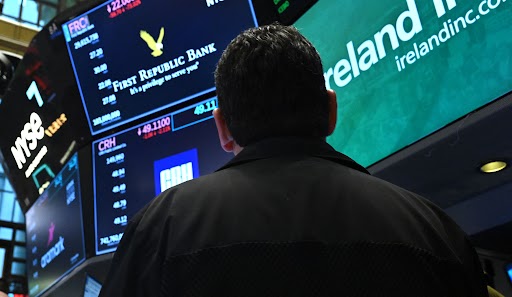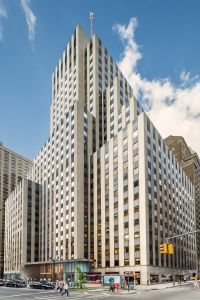Impact of Regional Banking Crisis Threatens CMBS Loans
By Brian Pascus March 16, 2023 6:23 pm
reprints
Several regional banks tied up in the ongoing national banking crisis serve as office tenants in properties backing hundreds of millions of commercial mortgage backed securities (CMBS), according to a Trepp report.
Utilizing the properties as both headquarters and branches, First Republic Bank (FRCB), Keybank (KEY) and Charles Schwab Corporation are top tenants in Trepp’s list of CMBS office loans to watch, with those loans ranging from $170 million to $565 million in size.
Trepp’s report— compiled as regional bank’s stock prices went into freefall this week—also includes other regional banks that could present potential tenancy risk to CMBS loan collateral, such as Comerica Bank, Huntington Bancshares, Western Alliance Bancorporation and Signature Bank (SBNY).
Despite the intervention by federal regulators into the operations of Silicon Valley Bank and Signature Bank — shuttered on March 10 and 12, respectively, there is still concern that the flight of deposits out of regional banks could cause a widespread run on smaller banking institutions.
Credit rating agency Moody’s announced earlier this week that it had placed six U.S. banks under review for a rating downgrade: First Republic Bank, Zions Bancorporation, Western Alliance Bancorp, Comerica, UMB Financial Corporation and Intrust Financial Corporation.
Stock prices for the regional banks cited by Trepp have tanked in the past week. Since March 9, First Republic shares are down 62 percent; KeyBank shares have dropped 23 percent; Comerica shares are down 23 percent; and Western Alliance shares had fallen by 32 percent upon the end of trading Thursday.
First Republic — which received a $70 billion liquidity injection from JPMorgan Chase and the Federal Reserve on March 12 — received a further $30 billion rescue deal Thursday from a consortium of banking competitors, including JPMorgan Chase, Wells Fargo (WFC), and Bank of America (BAC) evening in a bid to demonstrate confidence in the banking system.
“The Silicon Valley Bank experience has exposed or highlighted the issue of the interest rate mismatch — the borrowing short, lending long problem — that turns out to be not just a Silicon Valley Bank problem, but a more widespread issue,” said Lawrence J. White, professor of economics at the NYU Stern School of Business. “That banking model [itself] is problematic.”
The problems for the regional banking sector have now extended into commercial real estate by way of tenancy.
Trepp data released this week found First Republic is the second-largest tenant at 410 10th Avenue, a 631,944 square-foot office in Manhattan that was financed by a $565 million CMBS loan.
According to Trepp, other prominent CMBS loans collateralized by the tenancy of at-risk regional banks include a $201.8 million loan on Key Center in Cleveland, Ohio, where KeyBank holds roughly 30 percent of the space in a 1.37 million square-foot office complex; a $170.2 million loan on 211 Main Street in San Francisco, where Charles Schwab is the sole tenant on a 417,266 square-foot office lease that ends in 2028; and a $166.3 million loan on CityScape in Phoenix, a 641,935 square-foot mixed-use property where Western Alliance is the top tenant, carrying 33 percent of the space.
The uncertain fortunes of these regional banks — including the possibility of ratings downgrades, purchases or collapses — puts various commercial properties at risk of huge vacancies if their top tenants go under. That in turn impacts the value of the underlying mortgage backed securities attached to those commercial properties, according to White.
“We have known for 40 years that the really toxic assets on bank balance sheets are commercial real estate lending,” he said. “Whether it’s commercial real estate mortgages, whether it is bridge loans, or mezzanine loans, that stuff is toxic.”
For New York, perhaps the most troubling institution in the roster is the now-shuttered Signature Bank, with its loan originations spread across New York City’s sprawling commercial real estate sector.
Trepp data estimated that a whopping $25.5 billion of the bank’s $35.2 billion commercial real estate loan portfolio was tied to New York City properties, and that Signature Bank covered 12 percent of bank lending in commercial real estate in New York. Signature had previously noted in its 2022 10-K that all of the real estate collateral for the loans in its portfolio is located within the New York metropolitan area.
Multifamily mortgages encompassed $14.1 billion of Signature’s CRE portfolio; commercial mortgages made up $10.1 billion, while construction and land made up $1.1 billion, according to Trepp.
“The closure of Signature Bank will remove a significant source of liquidity in the New York commercial real estate market,” concluded Trepp analysts Matt Anderson and Stephen Bushbom.
To make matters worse, a February report from the Federal Deposit Insurance Corporation (FDIC) found that reports from 4,706 commercial banks and savings institutions across the U.S. carried unrealized losses on securities totaling $620.4 billion in the fourth quarter for 2022.
A report published by The Financial Times on Tuesday found First Republic, Comerica, Huntington, KeyCorp, and Western Alliance all had significantly lower tier 1 capital ratios than reported when unrealized losses on securities were adjusted to their balance sheets.
“If they were to acknowledge and reflect those losses, their capital positions would be substantially reduced,” White said. “They are simply less healthy than their misleading balance sheets indicate.”
Brian Pascus can be reached at bpascus@commecialobserver.com


